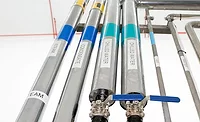HEATING HELP
Dan Holohan: Frozen steam coils
Think like steam.

Frozen steam coils always seem to happen at the worst of times, don’t they? You’re busy because it’s cold enough to freeze coils. The place with the frozen coil contains people who are doing things that are so important they can’t possibly be without that particular coil. Not even for a minute. They’re on the phone, and they’re not being reasonable.
And you’re doing the best you can.
So you get there as soon as you can and you look at the situation. The steam coil is frozen.
Yep. Rock-solid.
So do you replace it as is? You’ve got to get them back up and running, right? Or do you slow down for a few minutes and try to figure out why the steam coil froze. Because if it happened once, chances are it’s going to happen again. And the next time, they’ll be blaming you.
Life’s funny that way.
Someone wrote to me about a place that had hundreds of univentilator coils, but five of them kept freezing. It happened again and again. They were part of a two-pipe steam system that had pneumatic control valves and a condensate pump. They had replaced the F&T traps. The coils all tilted downward toward the condensate-return line. The F&T traps were about two feet below the coil outlets. The boiler pressure ran between 4- and 8-psi; and the boiler shut down at night until the coldest room in the building called for heat.
He wanted to know why those coils keep freezing.
I wrote back and told him to see if there was a vacuum breaker between the pneumatic control valve and the frozen univentilator. Vacuum breakers do exactly what their name implies, and vacuum is what you get when steam condenses unless air can get back in to break it.
He wrote back. There were no vacuum breakers on the frozen units.
What’s going on here is exactly what goes on when you hold your finger over the top of a straw that’s filled with water and then lift it out of the glass. Think of your finger as the vacuum breaker. Lift your finger to let atmospheric pressure enter the top of the straw and gravity does the rest.
But when it comes to steam coils, you can’t depend entirely on gravity to get rid of that condensate. The guy with the frozen coils said his traps were two feet below his coils, right? Okay, pretend you’re the condensate. You’re rising up inside the coil. The control valve is closed because the space is warm enough. The vacuum breaker just opened. You now have just two feet of vertical pipe in which you can stack and build static pressure. How strong are you feeling right about now? Not very, right? You’re producing less than 1-psi pressure down there at the bottom of your liquid stack. There’s a float & thermostatic steam trap down there and you’re pressing against it with a measly 1-psi pressure.
Feeling wimpy?
Yeah, me too.
And all of this assumes that the vacuum breaker is in place and working, of course. If it’s not, there will be a vacuum tugging you back into the coil and there will be little or no pressure on the inlet side of that F&T trap, which is why vacuum breakers are so important.
Now let’s take this a step further. There’s a valve pin and a valve seat inside that F&T trap, and the size of the hole in that seat has a lot to do with how much condensate is going to flow through the trap. A low-pressure trap has a relatively big hole in its seat because there’s not much pressure available on the inlet side of that trap (15-psi maximum) to shove the condensate through. High-pressure traps have much smaller holes in their seats because there’s more pressure available to do the shoving.
The challenge here is that a lot of people select these F&T traps for a differential pressure that’s going to occur when the control valve is fully opened. They’re figuring that steam at the maximum available pressure (4- to 8-psi in this case) is actually there. And a lot of people will assume that the pressure at the outlet side of the trap is atmospheric because the trap probably drains toward a vented condensate receiver.
So let’s say you pick a trap to move a certain load of condensate (which would be the univentilator’s rating) at a pressure differential of 4-psi (that being the seemingly worse case when the control valve is wide open). As long as the control valve is open, the condensate will drain by gravity (assuming there’s no pressure in the return line). But what happens when the control valve closes? Now, all you have going for you is static pressure, and that’s less than 1 psi. Assuming there’s no pressure in the return line beyond the trap, the condensate may decide to hang around for a while inside the coil because there’s just not enough differential pressure to make the trap work. I mean I’d hang around if I were the condensate. Wouldn’t you? And cold air surrounds that coil.
Now, let’s make our day a little bit more miserable. What if the pressure in the return line isn’t atmospheric? All it takes in one nearby trap to fail to put pressure in that return. Or one high-pressure trap that’s dumping flash steam into that return line (a common mistake). Or a vertical lift to an overhead return (which creates static backpressure on the trap’s discharge check valve). Or someone plugged the vent line on the condensate receiver because he’s tired of seeing the plumes of steam spewing from it (a nasty habit that some building superintendents acquire). Any of these things will change the pressure differential across the F&T trap, and cause the condensate to hang out inside the coil where it will mingle with Jack Frost.
An F&T trap is a dumb machine. It will not do the thinking for you, and it doesn’t care if you are happy or miserable from day to day. It just sits there like a doorstop and does nothing until you bring the proper combination of load and differential pressure to it. And you have to figure those two things at their worst-case conditions. You have to continuously ask that most important question: What if?
But let’s get back to our guy with the frozen univentilators. You know the guy in a hurry. He wants it fixed right now. And it should never ever happen again. His problem is interesting because those five univentilators don’t freeze every day. During the dead of winter when the control valves are open most of the time there’s never a problem. It’s the early spring and the late fall that will drive him nuts because those are the times when the control valves operate intermittently. The weather takes a turn toward freezing one day and the condensate backs up, freezes inside the coil and breaks that coil.
Can you see it in your mind’s eye? When control valves are involved, you have to size the F&T trap for the absolute minimum differential if you want it to work. Either that, or place it as far as possible beneath the coil (which may not be feasible). And don’t forget that all-important vacuum breaker on the outlet side of the coil.
Slow down and think like steam. Where do you want to go? Where are the air vents? Are they in the right place? Are they working?
Pretend you’re the condensate. What would you do? Can you drain properly? Imagine the straw. What’s lifting your finger off the top? Can you get out of that control valve before the freezing air gets to you?
Slow down and think. Thinking is your best tool. Take the time to use it.
sspopov/iStock / Getty Images Plus via Getty Images
Looking for a reprint of this article?
From high-res PDFs to custom plaques, order your copy today!








